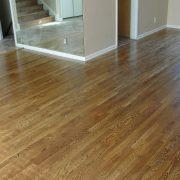How to Fix Those Loose and Squeaky Floorboards
If you have wood floors, the chances are pretty good that you’ll encounter a loose floorboard at some point in your life. Fortunately, these are fairly simple to fix if you know even the slightest bit about carpentry.
If you know nothing about carpentry, know this: floor boards tend to become loose when the screws or nails that are holding them down to the joists become loose. So if you find that this is the problem behind your loose floor board, take the time to replace the older screws or nails with new ones rather than reinforcing the older ones just to make sure you don’t have the exact same problem in a few weeks.
Some people may not even realize that they have loose floorboards but they do notice a squeak along the floor when someone walks across it. This is a surefire sign of a loose floorboard. If you start hearing the squeaking, pay close attention and look for any areas of the floor that seem uneven, or boards that aren’t quite flush with one another.
To fix the problem areas, remove all nails from the area even if they are not raised. When you do this, have a protective piece of wood or cardboard on the floor to protect the neighboring boards from damage from the hammer. If you have screws rather than nails, just use a power drill.
There’s no need to get fancy here; just place your new nails or screws into the existing holes. The only time to stray from this is if the existing holes are too far towards the edge of the joists. You want them located at the center for the best support. If you do end up creating new holes, make sure you cover the old ones in with the appropriate wood filler.
Once you have the board replaced, walk over it as you would any other time. If you continue to hear a squeak or the board still appears to be somewhat loose, remove it again and use a third nail or screw.
During this process, under no circumstances should you glue a floorboard down. This only ensures that you will have a nearly impossible time getting up when future problems arise or in the event that the entire floor might one day need to be replaced.






